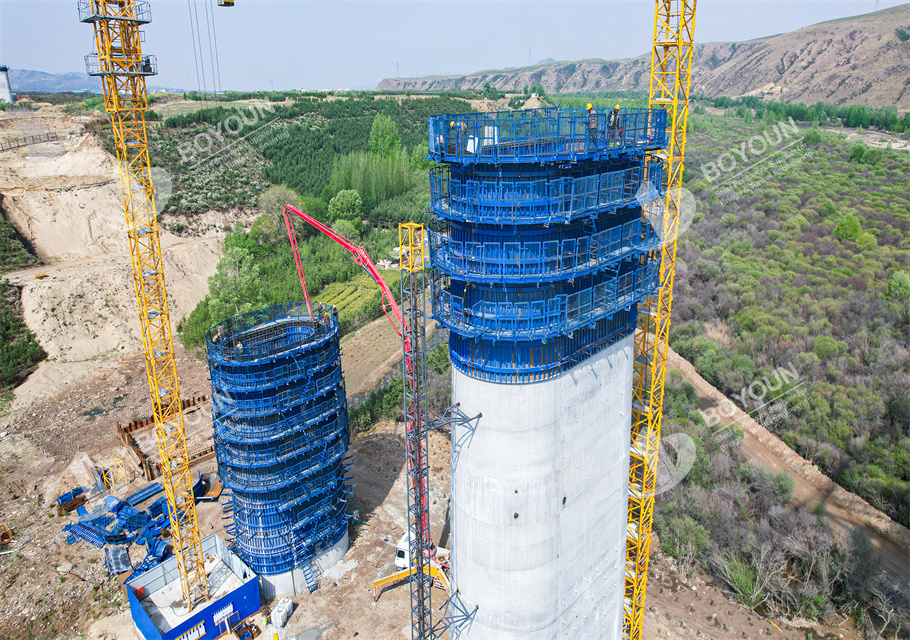(1) Cement control: Check the qualifications and integrity of the cement certificate and re - inspection report. At the same time, strictly control the anti-corrosion and moisture-proof measures for cement storage.
(2) Steel control: Check the integrity of the certificate and re - inspection report of the steel bar materials. At the same time, be mindful of the cleaning work and the appearance of the steel bar materials. The anti - corrosion and moisture - proof measures for storage at the construction site are crucial for the preservation of steel bar materials. When constructing on-site, the quality and size of the finished steel products are crucial for bridge construction.
(3) Cement and gravel control: Check the particle content, cement content, impurities, structural strength, composition density, and standard grade of sand - gravel.
(4) Concrete control: Check the proportion of raw materials of the concrete, the mix proportion of cement concrete, the mixing time, the later - stage curing, and the vibration work.

To ensure the highest quality construction of the bridge project, real-time inspections of the bridge pier quantities are necessary. The supervision department should keep track of the completion degree of the construction in real - time and conduct real - time inspections and surveys on the quality of the bridge construction part. Regularly inspect the equipment and machinery used for input construction materials to ensure the bridge's completion quality.
When constructing the bearing platform, the steel bars in the pier body should be embedded first. The positioning of the steel bar embedded work should be accurate. During the embedded construction, ensure that the thickness of the steel bar protective layer meets the standard requirements. Also, pay attention to ensuring that the spacing of the embedded steel bars is consistent with the previous design, avoid collisions and damage of the steel bars, and ensure that the steel bars fall vertically during the embedding to ensure the quality of the bridge project to the greatest extent.
When the pier body of the bridge is relatively high, the method of layered construction is usually used. If the pier body of the bridge is not very high, the one-time pouring method is usually adopted. The control of the verticality of the bridge pier body is the key aspect of bridge construction. The construction project department should dispatch a professional measurement team to detect the verticality of the bridge. Use instruments such as a level and total station to conduct plane positioning of the formwork position, elevation measurement, control verticality, and deviation of the bridge pier body template position, the height difference of the verticality, and the elevation deviation within the design range. If the formwork deviation exceeds the preset height, certain measures should be taken to solve the issue, such as lifting the formwork with a jack and inserting steel plates into the gaps for correction. Conduct repeated adjustments repeatedly. After vertical control of the pier body meets the requirements after accurate measurement, fill the gap with joint materials.
After the reinforced concrete is poured, take pile protection measures to restore the center of the bridge pier, and restore the pier body through the bridge control network. Conduct accurate measurement during the bridge pier lofting, and then concrete formwork erection work will be done in the first section of the pier body. At the same time, construct a reinforced concrete round platform and accurately locate the center of the bridge pier at the head of the embedded reinforced concrete. After installing the concrete bridge pier section formwork, check the installation status of the formwork around the bridge pier using a total station. To ensure the bridge pier meets the standard, carefully survey the diagonal of the template during construction and control the error range within 0.5 cm. For the concrete that has been poured, set up two monitoring instruments at each direction point, and complete the correction of the bridge pier through the construction methods of total station and wire pulling. During the template inspection, the measurement points of the bridge pier installation should be as close to the bearing platform as possible. Before inspecting, verify that the measurement points of the bridge pier are on the same straight line. If there are any deviations, take relevant measures to correct it in time. At the same time, in order to ensure the control of the perpendicularity of the pier body, accurately measure the perpendicularity of the bridge pier by using two plumb bobs. When installing two plumb bobs, make sure they are installed at two adjacent points on the bridge pier. During the monitoring process, use the water line to observe the position of the bridge pier and at the same time use the steel ruler equipment to detect the installation distance of the bridge pier. Adjust the formwork according to the data information to make it coincide, and adjust each surface to match the required position of the perpendicularity of the bridge pier.
During the bridge's construction process , the hollow wall of the bridge can be effectively applied, reducing capital investment costs and ensuring the bridge's efficiency and quality . Relevant personnel should adopt scientific and reasonable construction techniques and pay attention to the detail control during the pier construction process to enhance its quality.

International Department: Room 2507-2508, Tower C of Wanda Plaza, Tongzhou District, Beijing 101118, China.
+86-13021287080
info@boyoun.cn